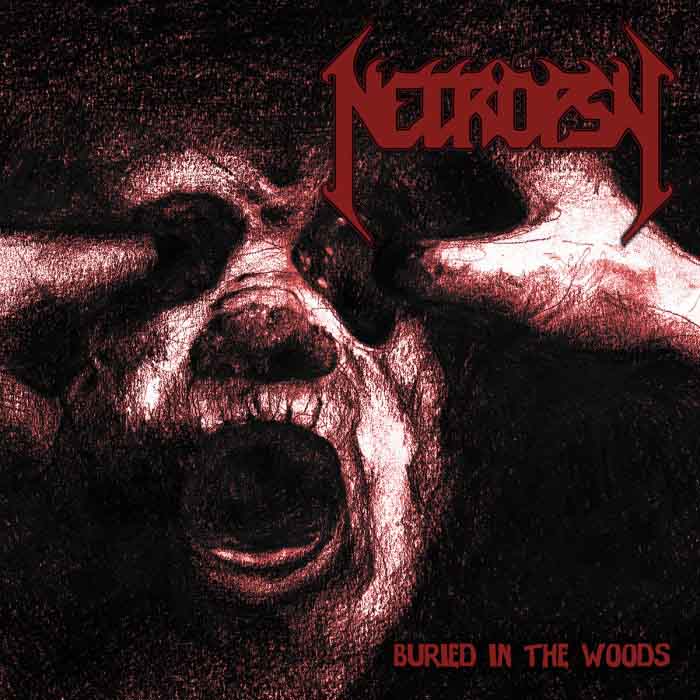
Article by Corey M
Finns Necropsy have been plugging away since 1989 but only recently (2011) released their first full-length album. In 2015 they released their second album, Buried in the Woods, showcasing a disciplined, modest, and even joyous approach to death metal. Every time I hear this album I get the sense that Necropsy’s members do not have any type of heady agenda or driving vision; rather they simply enjoy making plain-old death metal, emphasizing straightforward riffs that rely equally on rhythmic adherence and playful-but-conventional melodic deviations.
The actual sonic texture of the album is smooth and clear, taking full advantage of 2015’s recording technology. Both bass and distorted lead guitars are appropriately crunchy but never so deep and fuzzy as to approach the obscure levels of Infester or Incantation; they chug, ring, soar, and sing without losing a trace of clarity. This lucidity of individual tracks allows each instrument to be heard clearly and effortlessly, which is a major benefit since many of these songs shift back and forth between relatively uniform (all instruments playing the same thing) segments to more harmonically complex bits. Drums sit comfortably behind the melody, encompassing the other instruments and filling in the far left and right stereo space with just the right amount of reverb, never intruding on the melody. Meanwhile, the vocals only appear as low pitched roars that are somewhat hard to decipher, and mainly serve to augment the otherwise simple rhythmic interplay that generally features concomitant guitars and drums. During the last song, synthesized organ and string sounds come in to support the closing chord progression, but aside from this final track, the songs are functionally supported exclusively by the guitars, drums, and vocal patterns.
Judging by the description in the preceding paragraph, we should have all the ingredients necessary for a good death metal album. But, just as we find in actual food recipes, the order of ingredient addition, and time spent baking, are just as crucial to the final product as the ingredients themselves. Buried in the Woods is a smooth listen from front to back, as the creators probably intended. The casual listener may stop their analysis there; the more attentive listener may find that the conservative nature of the songs lend themselves to a relatively shallow range of dynamics. But this criticism is mainly aimed toward the album as a whole; the songs themselves move effortlessly between sections that slowly change in feel until making a satisfying shift back toward the introductory riffs. Nevertheless, by the fifth song you’ll have heard the band’s whole lexicon of riffs, which range from the derivative (mainly Grave-ish Swedeath and Sinister-ish NYDM) to the interesting-but-uninspired.
Finnish bands like Demilich and Demigod generated some bizarre death metal that, while unconventional by even death metal standards, was nevertheless intuitively relatable because the music presented a vision of horror that was spiritual-arising-from-the-biological. The songs expressed such extreme and severe experiences through a human lens that we as listeners were lead to question and explore our own peripheries of personal experience, and push our imaginations toward the impossible; that is the special territory of death metal. With this in mind, the generic horror concepts of Necropsy relate only to the biological and immediate sensations, falling short of that ability to breach into the “imaginal”; that territory in which we can experience events through the potency of imagination alone, affecting our feelings/biological chemistry on a profound scale.
Listen to Buried in the Woods because it illustrates several examples of a decently transparent and reliable template that can be used in constructing songs in a style as unorthodox as death metal. While you listen, you will probably find that such formulaic methods of song structure only work if there is a balance between surprise and rationality in the shifts between riffs. If the focus is too close toward surprise, the result is like metalcore, which lacks melodic structure and relies on rapid and unexpected dynamic shifts in rhythm and overall feel. If the focus is too close toward rationality, then you get something like Buried in the Woods, which is written skillfully enough to not be boring, but too conventionally to be exciting. Personally, I listened through it several times and developed fond feelings toward a few songs, but I won’t be listening to it again any time soon.
4 CommentsTags: 2015, buried in the woods, death metal, Finnish Death Metal, Necropsy

